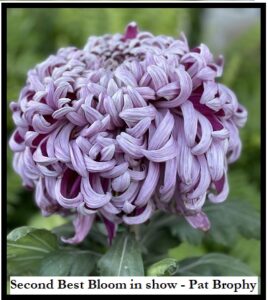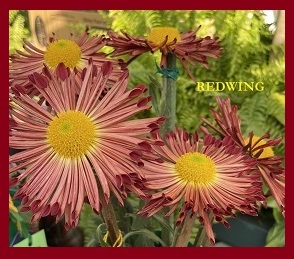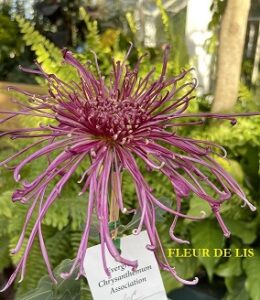EVERGREEN CHRYSANTHEMUM ASSOCIATION
Seattle, Washington
ECAMUMCLUB.ORG
Jim Anshutz, Secretary
HAPPY SPRING !
MEETING OF THE ECA – THURSDAY MAY 12th, 2011 at 7 PM at the Seattle Police Athletic Association Office (SPAA) site at 11030 East Marginal Way South, Tukwila.
PLANT SALE RESULTS
Congratulations to all who worked so hard growing plants for sale, setting up the event, and working as a great sales team yesterday. Chris Brookes reports that our results for the day look to be almost identical to last year. Total receipts were $1,662 which is close to the $1,657 Chris deposited after last year’s show. Chris notes that this years total includes some membership payments and cash for supplies which total almost $150. Our public plant sale at Furney’s therefore generated approximately $1,500. Added to this total are the proceeds from a third members plant sale at the April meeting and Ron Elliot kindly arranged for all of the unsold plants to be taken down to the Portland and Vancouver Washington clubs Mum sales. In total the sales of Members plants since April 1st 2011 are likely to add about $1,800 to the club coffers. A great job Bob Ewing and everyone!
Thanks to Larry Mayer for taking over the treasury duties during Chris’s vacation in Hawaii (so don’t bring return library books to the May meeting) and to Jill Aldrich for handling the Secretarial duties at the May meeting.
MAY MEETING-AMENDMENTS TO CONSTITUTION & BYLAWS.
Prior to being accepted for membership, the US National Chrysanthemum Society requires that we make certain minor changes to our Constitution and bylaws which must be approved by membership at a meeting.
The two changes required for membership in the US NCS are a) to reference annual dues but not reference an amount and clarify that our dues are paid annually and b) to acknowledge the important part that education plays in our club’s purpose in growing chrysanthemums. To respond to these two concerns members will vote on the following two amendments to our Constitution and Bylaws at the May meeting.
1. Amendment to Constitution
Article II of ECA Constitution would be amended as follows with the changes noted in bold italics and underlined:
The object of the Association shall be to educate and encourage the growing of Chrysanthemums by amateurs and to endow the Chrysanthemum with the popularity it justly deserves; to make it possible for the members to exhibit their Chrysanthemums at an annual show sponsored by the Association, or as co-sponsors with other Chrysanthemum groups; to extend the Association by permitting other Chrysanthemum groups now organized or to be organized, to become affiliated with this Association, or this Association may become affiliated with other Chrysanthemum organizations.
2. Change to By-Laws
Section 3 of the current By-Laws which reads as follows: would be deleted and replaced as follows:
Delete: “Membership fees shall be fifteen dollars ($15) for individuals and twenty dollars ($20) for couples per year. The fees are due no later than the March meeting”
Replace with “ Annual ECA membership fees will be set and reviewed periodically by the ECA Board of Directors. The fees are due no later than the March meeting.”
NEW MEMBERS
Welcome to Jane Evancho, Rich Kibbons, Nadine Quallotto and Alan Zalewski our clubs newest members who signed up during the Furney’s show!
YEARBOOKS
The 2011 ECA Yearbooks will be at the May meeting. We will mail Yearbooks to members who do not attend the May meeting. Thanks to Mark Ross for again taking on this big project!
UPCOMING EVENTS
Mark your calendars for the following events:
Garden Tour/Potluck – August 14
Aki Matsuri at Bellevue College – September 10 & 11th with set up on Sept. 9
Puyallup Fair – September 24th (date to be verified)
Fall Show at Furney’s – October 29 and 30th (with set up on Oct 28)
Awards Banquet at Angelos– November 10
PLANT CULTURE and SUPPLIES –Cultural suggestions are attached for May and will be discussed at the meeting. Remember to contact Mark Ross for soilless and supplies as needed.
If we are mailing you the monthly notice and you have an email address, please let Jim Anshutz know.
TO DO LIST for May and June (revised DRS 4/25/05)
Stopping:
Most plants are stopped April 15 through June 1, including the Early English classes. Keep your stop list handy and follow it rigorously. The calendar doesn’t move backwards. For #1 and #2 varieties the English literature recommends a fairly hard pinch; that is pinching 6-8 leafs down from the growing tip. For the incurves, #3, #13, #23 pinch the smallest portion of the growing tip to get more uniform growth of the laterals. For all varieties, fertilize 1-2 weeks before pinching to produce more laterals. This is especially true for the Fairweathers.
Final Potting into 8”, 9” or 10” pots. (Or maybe in the garden soil)
Preparation
Wash pots (in mild Clorox solution) then rinse in clear water.
Prepare potting mix. – Soil fewer users; add another 5-10% of screened pumice or Perlite to improve drainage. Also at this final stage, I recommend adding Cedar Grove compost or other fresh compost and a small amount of well-composted horse manure. This results in a mix of 6 parts M&R soil less, 4 parts compost, 1 part pumice, and small amounts of horse manure and Alfalfa meal.Water plants in the 6” pots 1 day before repotting.
Potting (Pot on when the ring of roots around the bottom of the pot is semi root bound.) Cover drain holes in bottom of clay pots with a piece of broken crock to keep drain clear. Put a layer of broken sod or course pumice in the bottom of pot, then cover with 1 or 2 inches of the final (9”) mix. Place the 6” root ball on top of the 9” mix and fill around with the 9” mix. The top of the root ball should be 1+ inch below the top of the pot. Do not pack the mix except as necessary to hold the plant and stake in place. Stake with shingle or bamboo stick.
Add Marathon Systemic at this time to control black aphids. Sprinkle ½ tspn. Marathon on top of soil when repotting plant, add a thin layer of mix over the top, then water moderately.
Note: When potting on occurs after June 1, Consider dropping down one pot size pot because the roots will not have time to fill the bigger pots. # 1 & #2 cultivars, 9” max, 8” could be used. #3s, 8” max.
Feeding and pest management
After 3 weeks in final pot start summer feeding program. ` 1 1 to 2 Tsp. Peters 20-10-20 per gallon water, once a week.
Note: Some plants will thrive with the heavier solution, while others
may not like so much fertilizer. Watch the leaves to gauge the fertilizer needed. If leaves become hard and curl up you are overfeeding. If leaves are somewhat weak and lighter green then more fertilizer would help. Miracle Grow is also used quite successfully by some during this summer stage.
If plants are yellowish, first try drying them out. If drying the plant is unsuccessful, feed ½ tsp. Epsom Salts per plant. Leaf feeding of liquid iron such as Greenall or Sequesterine also helps green up the plant. Follow product directions. Do not over feed Liquid Iron.
Review your pest management program every 2 weeks,
Marathon systemic is the most effective black aphid control.
Diazinon and most rose insecticides are somewhat less effective, and require spraying every 2 weeks, as they are contact insecticides. Spray every two weeks with a fungicide. Ortho Funginex is recommended. Other fungicides will work well if used regularly. If fungus gets away and is growing fast, a fungicide used to control early blight in tomatoes will really shut it down. I use Monterey “Bravo” for such control.
4. Lateral Control
As side laterals develop after the final pinch, select the number of laterals to carry through the summer and remove all other side shoots. Generally the topmost lateral below the stem break is removed, as it is the weakest lateral structurally and easily broken off by accident. At this early stage you should carry 1-2 more lateral than you want at the bloom stage. An old saying goes: “I grow 2 for me and one for the bug.”
Surplus laterals are removed later in the summer using the following guide.
For #1 & #2 cultivars, carry 2 or 3 laterals initially, cull to 1 or 2 in Aug.
For #3 cultivars, carry 5 laterals and cull Sept. or Oct.
For #4 & b#5 cultivars, carry 4 to 5 laterals and cull to 2 to 3 in Sept.
For Earliers (13-15 and 23-25) carry 4-5 laterals and cull to 2-3 in Sept.
For Spiders, Quills, Spoons, Singles etc. follow the guide for #4 and #5.
Note: Cutting back to the few laterals seems to be a most difficult task for the novice. You must do it however if you wish to get large blooms.
5. Staking.
By now all plants will require staking. A 16-24 in stake should be placed along the main plant stem and tied to it to support and protect the plant. As the side laterals develop it will be necessary to add longer stakes that can support each lateral all the way to bud development. Care must be exercised so as to not spread the new laterals too far apart when staking, as one or more could be broken off. In other words let the laterals grow till they can be easily tied to the new stakes.




